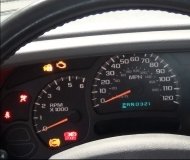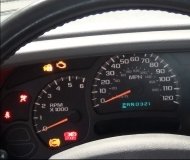Do a self test on the ECU, not all faults will set the check light, this should work you through the process, report any codes that come up.
Mark (mhpautos)
All Toyota vehicles with electronic fuel injection utilize the Toyota EFI or TCCS engine management system. This system incorporates many features to enhance performance, emissions, and drivability. One feature is the Self Diagnostic System. The self diagnostic system monitors engine operations and when a particular sensor or input varies out of specified operating parmeters, the "Check Engine" will be illuminated.
The check engine lamp alerts the driver or technician that a problem exists in the EFI/TCCS ECU or Engine Control Unit or "computer." When the check engine light is illuminated, it is indicating that a problem in the engine management system has been detected. At this time, a "code" may be stored in the ECU which pinpoints a possible component in the EFI/TCCS system. By checking the trouble codes, a possible problem could be narrowed down to a number of causes. While not an exact diagnostic tool, the check engine light and self-diagnostic system can get the individual working on his/her truck close to a possible fault, and, hopefully, to a successful repair.
Listed below are one and two digit trouble codes for the EFI/TCCS systems and possible causes. As mentioned above, this is not an exact science. Many other component failures can cause similar symptoms that can "mask" the actual cause. EFI/TCCS computer interrogation is one of the last steps to engine diagnostics. A thourough inspection of the simple items should be done prior to any computer-related repairs. Sometimes it's the simple things that will get ya'. In addition, use caution when working on the electrical system of your vehicle. Not only is the electrical system delicate to water, static electricity, and outright physical abuse, the ignition system puts out high voltage as well and you can be serioulsy injured if you do not exercise basic safety.
READING THE TROUBLE CODES
Reading the diagnostic trouble codes is very easy. You will need a paper clip to short the check connectors of the diagnostic connector. The diagnostic connector comes in two types. The early system is located on the inner-left fender well and is a round, green connector, usually located near the air cleaner. Simply jump the two terminals in this connector with the ignition switch in the "ON" position and the engine off. Later models, '87 and newer use a multiple terminal "DIAGNOSTIC" connector which is a small, rectangular-shaped grey "box", usually located near the right fender in the enigne compartment. To get codes out of this type of connector, jump the "TE1" and "E1" teminals. Finding these terminals is easy as the inside cover of the diagnostic connector contains a schematic of the connector pinouts. If the underhood emission decal (VECI) is still intact on your vehicle, the proper pins for this are outlined there as well.
The trouble codes will appear as flashes of the check engine lamp. Be sure the ignition key is on, the engine off, and your foot off of the accelerator when reading the codes. Two different codes may appear: One-digit and two digit. One digit codes have an approximate 4.5 second delay between flashes with the check engine light illuminating for about a half of a second. Mulitiple codes have a 2.5 second delay between them. For example a code two flashes the check engine lamp two times in a little over one second: I I. If two codes are stored, such as a code two and a code four, the lamp may flash as such:.I I.I I I I. Crude examples but you get the idea. Two digit codes are similar but will flash the lamp with the first number first and the second number last. An example of a code twleve is I. II and a code twenty four is I I. IIII.
SPONSORED LINKS
Saturday, May 23rd, 2020 AT 11:36 AM




